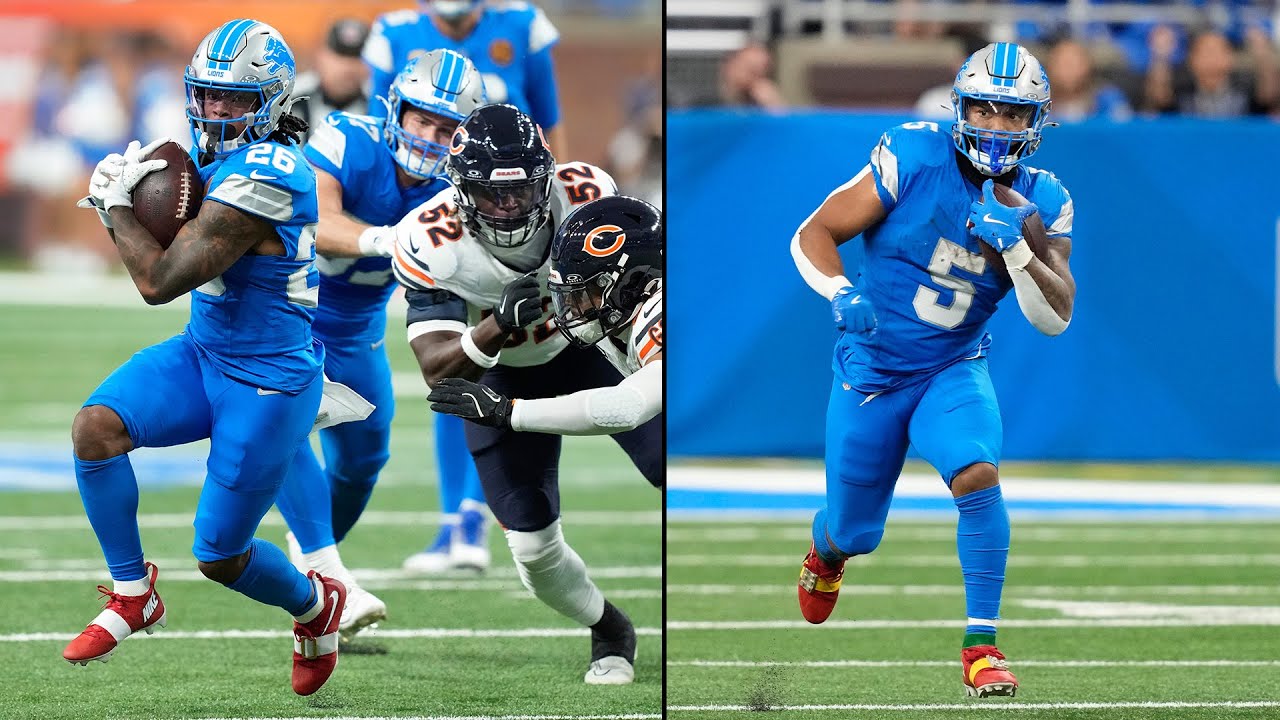All-22 Alert: How Roschon Johnson’s Vision, Violence and QB Brain Could Supercharge the Bears’ New 2025 Offense
The most revealing thing about diving into Roschon Johnson’s tape is how fast the film erases the lazy labels that trailed him from Texas to Chicago; he is not a depth-chart placeholder, not a situational hammer rolled out only when yardage is short, and certainly not the afterthought in a committee built around flashier skill sets. When you slow the All-22 and track his eyes, hips, and sequencing across different run schemes, you see a multi-phase problem-solver with a quarterback’s diagnostic processing, a linebacker’s appetite for collision, and the kind of foot discipline position coaches beg young backs to learn before the speed of NFL fronts chews them up. That combination becomes even more interesting as Chicago’s offensive architecture shifts in 2025 toward a wider marriage of motion, outside-zone surfaces, play-action shot layering, and selective gap-change calls designed to punish defensive overplay. Johnson fits that puzzle not because he’s the biggest or fastest back on the roster, but because he consistently does the little timing things that make the big calls work.
Start with vision, because zone football lives or dies on how patiently and honestly the back “presses” the initial landmark before committing. Johnson sells front-side intent long enough to stretch linebacker flow, then drops his pads and hinges his hips through a single-step cut that accesses the crease created by a climbing guard or a sealing tight end. It’s not a dramatic jump-cut; it’s economical, square, and timed to the half-beat when leverage flips. On previous seasons’ tape, when defenses loaded the box and tried to spike gaps, Johnson still generated functional yardage by refusing to declare early. That trait matters in the new look, where Chicago wants linebackers flat and late so mid-level crossers behind play-action stay clean. If the back rushes the read, the whole illusion collapses; if the back is patient and trustworthy, the passing layer blossoms.
Contact balance is the clip coaches keep bookmarking. Johnson rarely dies on first touch because he shortens stride into clutter, widens his base, and keeps his pads under the blow. Rather than absorbing and halting, he absorbs and rolls, corkscrewing through arm tackles to squeeze two or three hidden yards out of plays that most backs leave behind. That forward finish keeps the offense on script. Chicago’s analytics department has hammered home how second-and-6 unlocks the full install—quick game, boot, RPO tags, tempo checks—while second-and-10 collapses optionality. Johnson’s habit of turning glancing hits into modest wins might be the single most underrated fuel source for a scheme still smoothing edges.
His footwork under post-snap stress is equally encouraging. Defenses trying to choke cutbacks often scrape exchange or knife backside blitzers into the mesh. Johnson answers by throttling down, keeping his hips square to the line instead of turning early, and carrying “two-foot readiness” so he can jab-slide into the backside seam without losing power. When the picture muddies, he doesn’t panic-bounce; he compresses, hides behind the double, then re-accelerates when daylight reappears. That patience-with-a-plan trait lets coaches call the wide family—outside zone, mid-zone, split-flow slice—without fear that negative plays will bury drives.
Film study also lights up his pass protection, which could be the quiet hinge on his snap surge in 2025. Because Johnson began his college career at quarterback, his pre-snap routine is different: scan the nickel apex, check rotation depth, alert for creepers, reset alignment to give himself a strike angle on interior twist. When pressure comes, his hands stay tight, strike rises through the near number, and he keeps his head out of the block to re-fit if the rusher spins. Bears coaches are building more layered, longer-developing play-action and intermediate concepts; those calls only live if the back can pick up green-dog or simulate thick help on a free rusher. Johnson’s tape says he can be trusted in that space, which in turn keeps defenses honest about bringing heat.
His receiving portfolio isn’t highlight-reel explosion so much as pro-functionality—exactly what modern offenses need. Johnson sells check-release, chips when tagged, clears and settles with his numbers back to the quarterback, and flashes late hands so underneath defenders don’t jump the throw. Chicago has experimented with condensed splits that motion the back out wide to diagnose man versus zone; Johnson looks comfortable widening, stacking, and returning inside on option stems. In empty, he understands spacing rules and sits in soft zones rather than drifting into covered windows. These little details convert third downs and are catnip for quarterbacks who value reliable outlets when coverage rotates late.
Short-yardage credibility is still a Chicago winter requirement, and Johnson provides it without tipping off tendencies. When the Bears shift from stretch to downhill gap—duo, power, counter GH—he drops shoulders and explodes vertical behind the double rather than bouncing into lost-yard territory. Because he commits to the designed crease, defenses must honor interior fits, which in turn keeps the backside of zone honest when Chicago toggles back. Scheme multiplicity only matters if defenders believe you’ll actually run the whole menu; Johnson’s physical reliability on gap calls sustains that belief.
Tie it into the pass-game marriage and the explosive upside sharpens. If defenses squeeze to stop Johnson’s front-side press and backside cut, Chicago can climb into heavy play-action—deep crosses, post-over, leak wheel—to punish safeties who cheated. Conversely, once safeties bail, light boxes follow, and Johnson’s per-carry efficiency jumps. Offenses chase that feedback loop: run credibility widens throw windows, throw punishment lightens boxes, light boxes feed efficient runs. Johnson’s style—patient, square, punishing—greases the loop.
There’s an RPO and pistol wrinkle quietly expanding in offseason installs that could magnify him further. Align the back behind the quarterback, run wide flow one way, tag glance or stick opposite, and force the conflict defender to declare. Johnson’s mesh patience (again, quarterback origins) lets the quarterback ride the handoff just long enough to freeze linebackers, but when the ball stays with the back he’s already downhill with square pads and full menu vision. You get conflict stress without sacrificing downhill authority, and you get it from a back who won’t outrun his blocks trying to manufacture splash.
The numbers available from internal charting back the eye test even if the public sample remains modest. In stretches where Johnson logged double-digit touches, Chicago’s run efficiency and drive sustain rate rose meaningfully; the gains weren’t all explosive plays but rather a stack of successful downs that kept the call sheet open. Small sample warnings apply, yet the pattern tracks with what the film shows: give a disciplined runner enough reps for the blocking surface to settle and the floor rises. That floor stability is gold for a developing offense.
Workload design will shape the ceiling. The Bears don’t need to chase 25-touch workloads to feel Johnson’s influence; something in the 10-to-12 carry range layered with high-leverage pass-pro downs and a handful of designed targets may be optimal. Because he finishes forward and protects well, his “hidden yardage plus protection saves” value compounds even on modest raw volume. That aligns with a broader 2025 philosophical shift toward spreading touches while leaning on situational specialists who keep the offense efficient and the defense rested.
Growth areas remain. Ball carriage security through second-contact spins can tighten; pursuit defenses will rake at the ball as he rolls. Coaches will harp on two-hand security sooner in traffic. Long speed won’t suddenly appear, so explosives must be manufactured via angles—screens, misdirection throws, late leaks off play-action drags where the defense vacated the flat to plaster crossers. None of these needs are red flags; they’re normal evolution checkpoints for a back ascending from rotational to featured usage.
Project the arc forward and a plausible breakout map emerges. Early weeks: balanced rotation while the line acclimates to expanded wide-zone footwork. Midseason: snap share climbs as trust in protection and decision speed earns long-drive snaps. Post-bye: defenses crowd to solve Chicago’s intermediate passing game, boxes lighten, and Johnson’s efficient sequencing turns into chain-moving volume. Sprinkle in a couple of well-timed screens that punish aggression and suddenly the conversation around Chicago’s offense shifts from “Can they survive?” to “Can they dictate?” Johnson is the kind of back who helps an offense flip that script quietly, without the weekly highlight blast that draws national noise—until the cumulative effect becomes impossible to ignore.
All of this lands in a city wired to celebrate backs who grind out yards the hard way. Chicago fans respect production, but they revere effort that bleeds into identity: lowered shoulders in freezing wind, extra drive after contact, doing the dirty work in protection so explosive throws can happen. Johnson’s biography—high school quarterback, position change at Texas, special-teams grinder, locker room reputation for film habits—maps almost eerily onto the blue-collar mythology the Bears have always claimed. In a market that can sniff out manufactured hype, authenticity matters; Johnson runs and blocks like someone who understands that every rep is public evidence.
Should he hit, the ripple touches every unit. Reliable early-down yardage shrinks third-and-long volume and cools opposing pass rush plans. Sustained drives extend possession share, which helps a defense that wants fresh legs to weaponize its pass rush late. Play-action explosives built off Johnson’s credibility accelerate quarterback development by gifting cleaner windows and simpler post-snap pictures. Field position swings as punts shorten. Complementary football, so often an empty coaching cliché, becomes visible in the box score because one back kept the offense “on color” and on schedule.
So pull up the cut-ups and watch the little tells: the way he leans into the double without overrunning it, how he re-loads balance after glancing contact, how his eyes stay disciplined when fronts stem late, how he squares blitzers and re-fits if they spin, how he sells swing before pivoting up the seam, how he refuses to bounce gap when the crease is muddy, how he treats every carry like a chance to tilt the next call. Those are the things that build trust, and trust builds touches, and touches build stories. If you’re hunting for the next under-the-radar player who could tilt an entire offensive identity in 2025, you may not need to look past No. 23. Roschon Johnson has the vision to set up blocks, the violence to finish them, the quarterback brain to protect the passing game, and the perfect runway in Chicago’s evolving system to put it all together when the weather turns and every yard matters.



